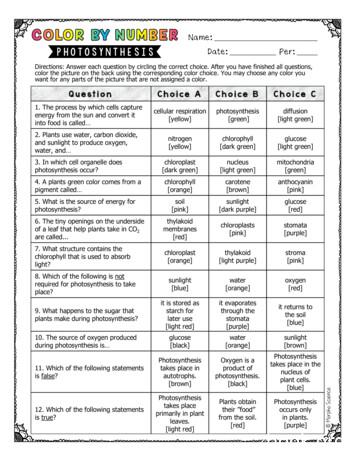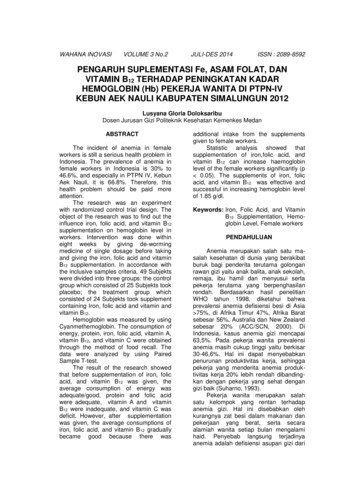Warm-Up Photosynthesis And Cellular Respiration
Warm-UpPhotosynthesis and Cellular RespirationLesson ObjectivesBy the end of this lesson, you should be able to: Illustrate and describe the energythat occur duringphotosynthesis and respiration. Compare and contrast the processes ofcellular.Science Practice: Evaluate data to formulate aW2Kand.Words to KnowWrite the letter of the definition next to the matching word as you work through thelesson. You may use the glossary to help you.adenosine triphosphatecellular respirationphotosynthesis Edgenuity, Inc.A. a process that breaks down glucose toprovide energy in the form of ATP formetabolic processesB. the process by which green plants,algae, and some bacteria capture lightenergy to form simple sugars usingwater and carbon dioxide (CO2), andrelease oxygen gas as a by-productC. an energy-storing molecule in a cellthat is composed of one adenosinemolecule (adenine and ribose sugar)and three phosphate groups, ispresent in all living organisms, and isused to fuel activities within a cell1
InstructionPhotosynthesis and Cellular RespirationSlide1LessonQuestion2Definition of Photosynthesisis the process by which green plants, algae, andsome bacteria captureenergy to form simpleusingwater and carbon dioxide and release oxygen gas as a by-product.Used by Edgenuity, Inc.2
InstructionPhotosynthesis and Cellular RespirationSlide2Definition of Cellular Respirationis the process thatglucose to provideUsed byin the form of ATP for metabolic processes.andUsed by.(ATP) is a high-energy storing moleculein cells: composed ofsugar) and used to fuel Edgenuity, Inc.adenosine molecule (adenine and ribosephosphate groupsin all living organismswithin a cell3
InstructionPhotosynthesis and Cellular RespirationSlide2Energy Flow through the Biosphere Energy comes from the Sun and gets trapped or converted by the. Thethen eat those producers. So,flows from thethrough the producers to theconsumers.4Focus on Photosynthesiscaptures energy from the Sun and stores it as glucose. Overall photosynthesis reaction equation:6CO2 6H2O Light-energy 6O2 C6H12O6reactions: Chloroplasts capture solar energy,water molecules are split, electrons are transported, H ions are released,andis made. Light-reactions: Calvin cycle uses energy in ATPto add carbon dioxide to carbon-based molecules to make. Edgenuity, Inc.4
InstructionPhotosynthesis and Cellular RespirationSlide4Focus on Cellular Respirationbreaks down glucose to obtain usable energy. Overall cellular respiration reaction equation:6O2 C6H12O6 6CO2 6H2O : energyglucose into pyruvate and makes ATP.: Forms citric acid and breaks it down to formcarbon dioxide and make .transport chain: ElectronsH ionsacross a membrane. H ions then produce more ATP and combinewith oxygen to form water.6Specialized OrganellesFill in the boxes to label the organelles.Photosynthesis Edgenuity, Inc.Cellular Respiration5
InstructionPhotosynthesis and Cellular RespirationSlide9Chemical Reaction Cycles Photosynthesis includes thecycle, which fixes carbon dioxideinto glucose. Cellular respiration includes thecycle which breaks downglucose, eventually producing ATP.Uses of ATP and Electron Transport ChainsPhotosynthesis and cellular respiration use:: Cellular respiration and photosynthesis produce and use ATP tocarry energy for the various reactions within each process. uses the ATP produced to synthesizeglucose. creates a net positive amount of ATPafter breaking down glucose. Electronchain: Both reactions use carrier molecules totransport electrons. Photosynthesis uses the chainwhen sunlight energizeselectrons. Cellular respiration uses the chain Edgenuity, Inc.after glucose is broken down.6
InstructionPhotosynthesis and Cellular RespirationSlide12Photosynthesis and Cellular Respiration Reactants and products are .of one process areof the other.Fill in the boxes to identify the processes in the diagram.14Storing vs. Releasing Energy Photosynthesis Cellular respiration Edgenuity, Inc.energy.energy.7
InstructionPhotosynthesis and Cellular RespirationSlide14Different Processes for Different OrganismsPhotosynthesisCellular respiration Some Some 16Complementary Processes of Photosynthesis and CellularRespirationPhotosynthesisCellular respiration6CO2 6H2O energy 6O2 C6H12O6 6O2 C6H12O66CO2 6H2O energy oxygen oxygen carbon dioxide carbon dioxide water water Synthesizes Uses Breaks downenergy Releasesenergy Edgenuity, Inc.8
InstructionPhotosynthesis and Cellular RespirationSlide18Cellular Respiration and ExerciseREAL-WORLD CONNECTIONSports medicine researchers study cellular respiration in athletes. Muscles useto release energy. Cellular respiration requires Change in gasesand releases carbon dioxide.andindicate amount ofcellular respiration taking place.Percentages of Gases in Air Inhaled and ExhaledREAL-WORLD CONNECTIONThe table shows data about the percentages of gases in air inhaled and exhaled.The gases are oxygen (O2), nitrogen (N2), and carbon dioxide 78.15%4.46% The percentage of The percentage of(N2) stays the same.(O2) and(CO2) change.The chemical process ofaccounts for thechanges in the amount of oxygen and carbon dioxide. Edgenuity, Inc.9
Summary?LessonQuestionPhotosynthesis and Cellular RespirationWhat are the similarities and differences between photosynthesisand cellular respiration?Answer Edgenuity, Inc.10
SummaryPhotosynthesis and Cellular RespirationSlide2Review: Similarities between Photosynthesis and CellularRespirationBoth photosynthesis and cellular respiration: deal withconversion. occur in specialized use a.of chemical reactions. use and produce use.transport chains.Review: Differences between Photosynthesis and CellularRespirationPhotosynthesis and cellular respiration: have different deal withand products.and releasing energy differently. are carried out by different are complementary Edgenuity, Inc.11
SummaryPhotosynthesis and Cellular RespirationUse this space to write any questions or thoughts about this lesson. Edgenuity, Inc.12
Review: Differences between Photosynthesis and Cellular Respiration Summary Photosynthesis and Cellular Respiration 2 Review: Similarities between Photosynthesis and Cellular Respiration Both photosynthesis and cellular respiration
1. Photosynthesis and cellular respiration can be described as complementary processes. a. Write the chemical formula for cellular respiration and the chemical formula for photosynthesis. b. Describe how cellular respiration and photosynthesis are evidence of the First Law of Therm
Photosynthesis takes place in autotrophs. [brown] Oxygen is a product of photosynthesis. [black] Photosynthesis takes place in the nucleus of plantcells. [blue] 12. Which of the followingstatements is true? Photosynthesis takes place primarily in plant leaves. [light red] Plants obtain their ”food” from the soil. [red] Photosynthesis .
photosynthesis 1/2-5/2 8/2 S1-5 Picnic Day 9/2-19/2 Lunar New Year Holiday photosynthesis 11A 4/6 Chapter 21 Photosynthesis o Basic concepts of photosynthesis o Requirements for photosynthesis o Site of The process of photosynthesis oPre Lesson Worksheet o Communication s
Photosynthesis Chapter 8 2 Photosynthesis Overview Energy for all life on Earth ultimately comes from photosynthesis. 6CO 2 12H 2O C 6H 12O 6 6H 2O 6O 2 Oxygenic photosynthesis is carried out by: cyanobacteria, 7 groups of algae, all land plants 3 Photosynthesis Overview Photosynt
2. Read through the PowerPoint slides on Photosynthesis and Cellular Respiration. 3. Complete the Practice Questions in your second section. 1. Title: Photosynthesis and Cellular Respiration 4. Make sure you are able to answer the Essential questions at the end of the P
Cellular Processes Compare and contrast Photosynthesis and Cellular Respiration in the Venn Diagram (include at least 2 facts per section) Photosynthesis Cellular Respiration Sample Question: Which of the following statements best describes the relationship between photosynthesis and respiration? a.
Cellular respiration, in turn, is the process all organisms require to derive energy from the products of photosynthesis (for example, sugars) they consume. The carbohydrates produced by photosynthesis can be used to drive multiple different metabolic processes, including cellular respiration
Fe, asam folat dan vitamin B 12). Dosis plasebo yaitu laktosa 1 mg (berdasarkan atas laktosa 1 mg tidak mengandung zat gizi apapun sehingga tidak memengaruhi asupan pada kelompok kontrol), Fe 60 mg dan asam folat 0,25 mg (berdasarkan kandungan Fero Sulfat), vitamin vitamin B 12 0,72 µg berdasarkan atas kekurangan























